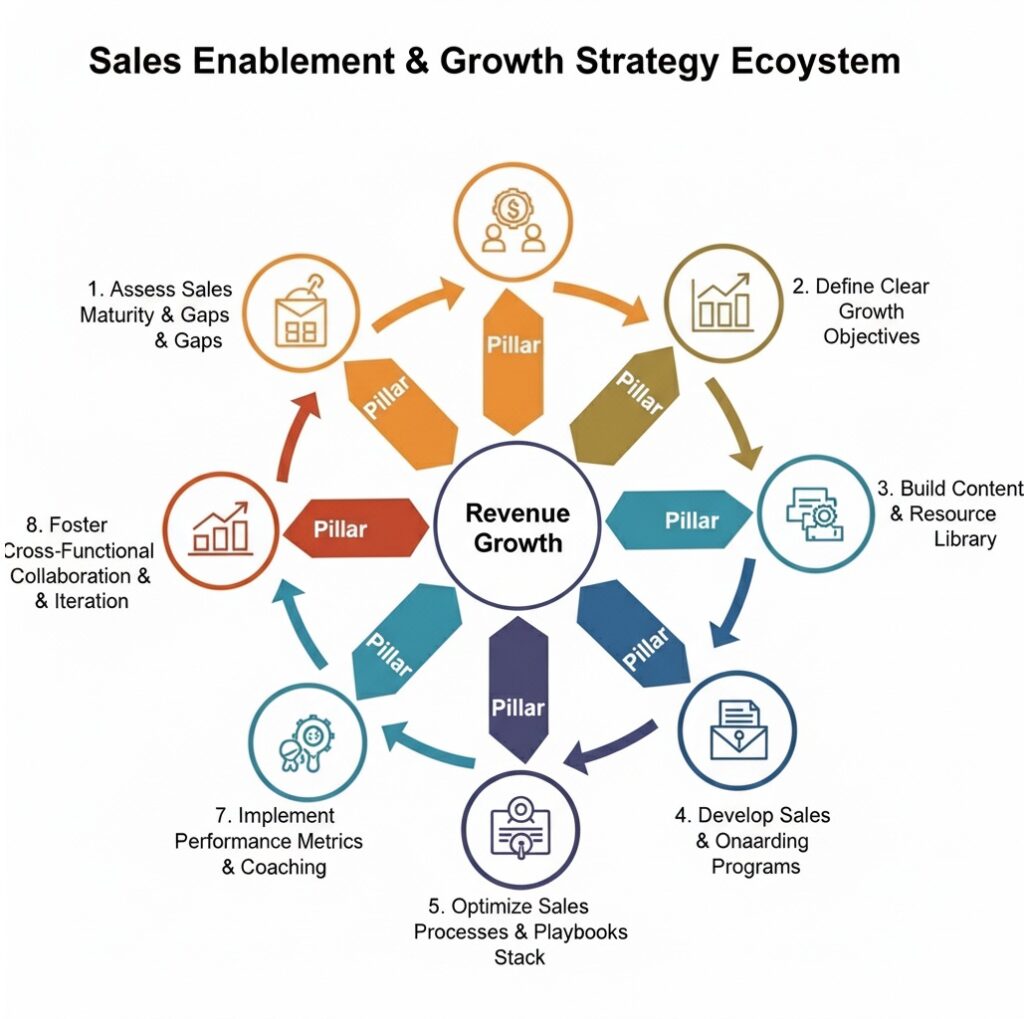The Ultimate Guide to B2B Sales Enablement & Growth Strategy
What is Sales Enablement?
Let’s start with a simple definition. Sales enablement is the process of giving your sales team everything they need to win.
Think of it as the power-up that equips your team with the right tools, content, and training to engage buyers and close deals faster. It’s the essential link between sales and marketing, ensuring everyone is on the same page and working toward the same goal: revenue growth.
Why Your Business Needs a B2B Sales Enablement Strategy
In a competitive market, you can’t just hope for growth—you have to enable it. An effective sales enablement and growth strategy is the engine that drives predictable, scalable revenue.
- Boost Performance: Cut sales cycles by up to 30% and get new hires ramped up and hitting their targets faster.
- Empower Your Team: Give your reps the resources they need to succeed, boosting their confidence and leading to higher quota attainment.
- Accelerate Revenue: Tie every effort to clear business outcomes, making your growth predictable and sustainable, even in complex B2B environments.
- Adapt to Change: Build a resilient sales organization that can quickly pivot and thrive regardless of market shifts.
- Maximize ROI: Lower the cost of each deal while increasing customer lifetime value.
The 8 Pillars of a Winning Sales Enablement Framework
This 8-pillar framework is designed to build a complete, scalable ecosystem for your sales team. Follow these steps to transform your approach from a series of reactive tactics to a proactive, data-driven strategy.
1. Assess Your Current Sales Process
Before you build, you have to know where you stand. Figure out the strengths and weaknesses of your current sales process, from lead generation to deal closure.
- Action: Conduct a quick audit using surveys, win/loss analysis, and a review of your pipeline.
- Tip: Don’t treat everyone the same. New reps have different needs than seasoned veterans.
2. Define Clear Growth Objectives
Your enablement efforts should have a purpose. Work with leadership to set specific, measurable goals that align with your overall business strategy.
- Action: Hold a workshop to define what success looks like, focusing on key results like increasing upsell rates or shortening the sales cycle.
- Tip: Focus on tangible business outcomes, not just sales activities.
3. Build a Central Content & Resource Library
Give your team instant access to everything they need to handle a sales conversation. This includes case studies, battle cards, and one-pagers that are easy to find and use.
- Action: Audit your existing content and build a plan to fill the gaps, creating resources tailored to each stage of the buyer’s journey.
- Tip: Always include ROI proof and competitor intelligence, and update your content quarterly to stay relevant.
4. Develop Smart Training & Onboarding
Get your reps up to speed quickly with a training program that builds real-world skills and confidence.
- Action: Create a curriculum that blends in-person training with self-paced learning modules on topics like product knowledge and objection handling.
- Tip: A good onboarding program can reduce the time it takes for a new hire to become productive by 25% or more.
5. Optimize Sales Processes & Playbooks
Create a repeatable system for success. Standardize your workflows with clear, flexible playbooks for different sales scenarios.
- Action: Map out your entire sales process, from the first contact to a signed deal. Use tools to create a flow that your team can easily follow.
- Tip: Integrate proven methodologies like SPIN Selling or MEDDIC directly into your playbooks.
6. Integrate the Right Tech Stack
Technology should amplify your team’s efforts, not complicate them. Choose and deploy tools that work together seamlessly.
- Action: Evaluate your current stack (CRM, marketing automation, etc.) and identify tools that can streamline communication and increase efficiency.
- Tip: Start with just a few core tools and ensure your team is trained to use them effectively to avoid “tech overload.”
7. Implement Metrics & Coaching
What gets measured, gets managed. Track key performance indicators (KPIs) and use that data to provide meaningful, one-on-one coaching.
- Action: Set up dashboards to track metrics like win rates and pipeline velocity. Schedule regular coaching sessions based on what the data shows.
- Tip: Use AI-driven call insights to provide personalized feedback and help your reps improve their talk track.
8. Foster Cross-Functional Collaboration
Break down internal silos. Your sales enablement strategy should be a living thing, constantly refined by feedback from marketing, sales, and customer success.
- Action: Schedule regular check-ins and alignment meetings to ensure all teams are working toward the same goals.
- Tip: Get your customer success team involved early to help identify opportunities for expansion and upsell.
The Sales Enablement & Growth Strategy Ecosystem
This diagram shows how each of the 8 pillars works together to create a powerful ecosystem. When implemented effectively, these components don’t just exist in isolation—they constantly feed into each other, creating a cycle of continuous improvement and accelerated B2B revenue growth.

